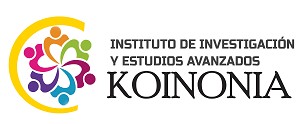Aprendizaje de emprendimiento y gestión a través de narrativas gigitales en bachillerato
Resumen
El presente trabajo tiene por objeto analizar la contribución de las narrativas digitales al proceso de enseñanza-aprendizaje de Emprendimiento y Gestión de los estudiantes de Segundo BGU de la Unidad Educativa “Luis Rogerio González”. El enfoque es cuantitativo con un alcance descriptivo no experimental, de cohorte transversal. El instrumento estuvo conformado de 10 variables en la escala Likert. Para la tabulación de datos se utilizó la herramienta Excel y para su análisis estadístico la herramienta SPSS. El conocimiento de los estudiantes sobre las cuestiones TIC, educación financiera, administración eficaz y conceptos básicos de economía es de nivel media-alta; sin embargo, no hubo asociación significativa entre las variables cuestiones TIC y educación financiera. Se desarrolló una propuesta basada en la implementación de las narrativas digitales con el objetivo de mejorar el conocimiento de los estudiantes mediante la narrativa digital.
Descargas
Citas
Acosta, A. H. (2015). Narrativas digitales como didácticas y estrategias de aprendizaje en los procesos de asimilación y retención del conocimiento. Sophía, 19, 253–270. https://n9.cl/2jw9e
Acosta, A. H. (2018). Innovación, tecnologías y educación: las narrativas digitales como estrategias didácticasKillkana Sociales: Revista de Investigación Científica, 2(2), 31–38. https://n9.cl/17ije
Addine, F. (1998). Didáctica y optimización del proceso de enseñanza-aprendizaje. IPLAC.
Alonso, E., & Murga, V. A. (2018). Enseñar y aprender con narrativa transmedia. Análisis de experiencia en una escuela secundaria de Argentina. Comunicación y Sociedad, 33, 203–222. https://n9.cl/tvowl
Angulo, C. A., & Alape Chilatra, D. P. (2018). Una secuencia didáctica basada en narrativas digitales para fortalecer la producción escrita en los estudiantes del grado once de la institución educativa Alberto Carvajal Borrero [Universidad ICESI]. https://n9.cl/5itfi
Asamblea Nacional Constituyente. (2008). Constitución de la Republica del Ecuador. Registro Ofcial 449 de 20 Oct. 2008, 1–222. https://n9.cl/zy5f
Del Moral, M. E., Villalustre, L., & Del Rosario Neira, M. (2016). Relatos digitales: activando las competencias comunicativa, narrativa y digital en la formación inicial del profesorado. Ocnos-Revista de Estudios Sobre Lectura. https://n9.cl/wj6rk5
Enciso, E. M. V, Arias, J. V, & Arias, A. V. (2016). No Title. Kepes, 13(13), 197–231.
Erazo Álvarez, J. C. (2021). Capital intelectual y gestión de innovación: Pequeñas y medianas empresas de cuero y calzado en Tungurahua–Ecuador. Revista De Ciencias Sociales, 27, 230-245. Recuperado a partir de https://produccioncientificaluz.org/index.php/rcs/article/view/37004
Hermann-Acosta, A., & Perez-Garcias, A. (2019). Narrativas digitales, relatos digitales y narrativas transmedia. Revisión sistemática de literatura en educación en el contexto iberoamericano.. Revista Espacios, 40(41). https://n9.cl/ejazg
Koenitz, H. (2015). Towards a specific theory of interactive digital narrative. In Interactive Digital Narrative: History, Theory and Practice (pp. 91–105). Taylor and Francis. https://doi.org/10.4324/9781315769189-8
Koenitz, H., Palosaari Eladhari, M., Louchart, S., Nack, F., Roth, C., & Mekler, E. (2020). A shared vocabulary for IDN INDCOR white paper 1 Version 1.0 Authors of sample entry. https://indcor.eu
Mineduc. (2020). Currículo Priorizado para la Emergencia. Quito: Ministerio de Educación. https://n9.cl/ty6jd
Naciones Unidas. (2020). Respuesta integral de las Naciones Unidas a la COVID-19: salvar vidas, proteger a las sociedades, recuperarse mejor. 44. https://n9.cl/fgag
Peralta-García, L., & Ouariachi-Peralta, T. (2015). El potencial educativo de las narrativas digitales en la comunicación para el cambio social. Jóvenes Frente al Cambio Climático como estudio de caso. Obra Digital: Revista de Comunicación, 8, 40–61. https://n9.cl/tdvz3
Rius, N. I., & Roca, J. B. (2016). Book tráiler en Educación Infantil y Primaria: adquisición y desarrollo de la competencia comunicativa, digital y literaria a través de narrativas digitales. [Digital Education Review, 30, 76–93. https://n9.cl/12wdk
Rodríguez-Ruíz, J. A. (2006). El relato digital: hacia un nuevo arte narrativo. Bogotá: Libros de Arena. https://n9.cl/eada9
Sánchez-López, I. (2020). Narrativas en la era digital: mediaciones del relato y empoderamiento creativo en la generación Z. https://n9.cl/qfum1
Vázquez-Cano, E. (2015). El reto de la formación docente para el desarrollo de una metodología ubicua en la Educación Superior. Perspectiva Educacional, 54(1), 149–162. https://doi.org/10.4151/07189729-vol.54-iss.1-art.236
Villa, E. F. (2021). Uso de la narrativa digital para la ayuda de la comprensión lectora en el área de lengua y literatura de cuarto año de Educación General Básica en la Unidad Educativa Miguel Díaz Cueva, año lectivo 2019-2020. [Universidad Politécnica Salesiana]. https://n9.cl/3bdns
Derechos de autor 2021 Verónica Alexandra Neira-Quinteros, Cristián Andrés Erazo-Álvarez

Esta obra está bajo licencia internacional Creative Commons Reconocimiento-NoComercial-CompartirIgual 4.0.
CC BY-NC-SA : Esta licencia permite a los reutilizadores distribuir, remezclar, adaptar y construir sobre el material en cualquier medio o formato solo con fines no comerciales, y solo siempre y cuando se dé la atribución al creador. Si remezcla, adapta o construye sobre el material, debe licenciar el material modificado bajo términos idénticos.
OAI-PMH URL: https://cienciamatriarevista.org.ve/index.php/cm/oai














